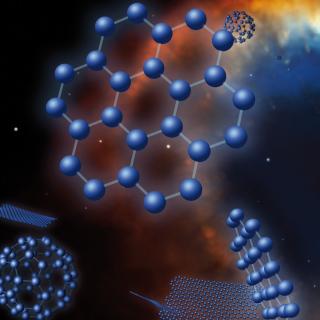Bibcode
Cheng, Xinlun; Anguiano, Borja; Majewski, Steven R.; Hayes, Christian; Arras, Phil; Chiappini, Cristina; Hasselquist, Sten; de Andrade Queiroz, Anna Bárbara; Nitschelm, Christian; García-Hernández, Domingo Aníbal; Lane, Richard R.; Roman-Lopes, Alexandre; Frinchaboy, Peter M.
Referencia bibliográfica
The Astrophysical Journal
Fecha de publicación:
12
2020
Revista
Número de citas
42
Número de citas referidas
36
Descripción
Previous analyses of large databases of Milky Way stars have revealed the stellar disk of our Galaxy to be warped and that this imparts a strong signature on the kinematics of stars beyond the solar neighborhood. However, due to the limitation of accurate distance estimates, many attempts to explore the extent of these Galactic features have generally been restricted to a volume near the Sun. By combining the Gaia DR2 astrometric solution, StarHorse distances, and stellar abundances from the APOGEE survey, we present the most detailed and radially expansive study yet of the vertical and radial motions of stars in the Galactic disk. We map velocities of stars with respect to their Galactocentric radius, angular momentum, and azimuthal angle and assess their relation to the warp. A decrease in vertical velocity is discovered at Galactocentric radius R = 13 kpc and angular momentum Lz = 2800 kpc km s-1. Smaller ripples in vertical and radial velocity are also discovered superposed on the main trend. We also discovered that trends in the vertical velocity with azimuthal angle are not symmetric about the peak, suggesting the warp is lopsided. To explain the global trend in vertical velocity, we built a simple analytical model of the Galactic warp. Our best fit yields a starting radius of ${8.87}_{-0.09}^{+0.08}\ \mathrm{kpc}$ <!-- --> and precession rate of ${13.57}_{-0.18}^{+0.20}\ \mathrm{km}\ {{\rm{s}}}^{-1}\ {\mathrm{kpc}}^{-1}$ <!-- --> . These parameters remain consistent across stellar age groups, a result that supports the notion that the warp is the result of an external, gravitationally induced phenomenon.
Proyectos relacionados

Nucleosíntesis y procesos moleculares en los últimos estados de la evolución estelar
Las estrellas de masa baja e intermedia (M < 8 masas solares, Ms) representan la mayoría de estrellas en el Cosmos y terminan sus vidas en la Rama Asintótica de las Gigantes (AGB) - justo antes de formar Nebulosas Planetarias (NPs) - cuando experimentan procesos nucleosintéticos y moleculares complejos. Las estrellas AGB son importantes
Domingo Aníbal
García Hernández